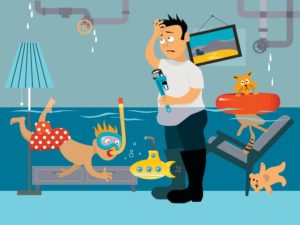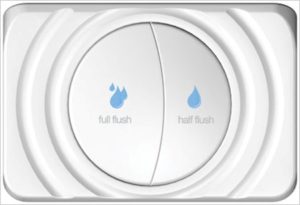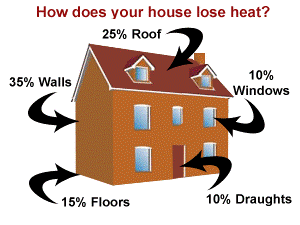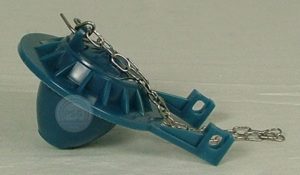Tag Archives: blog
How You Can Benefit from a Water-Powered, Back-up Sump Pump
The key to maintaining a dry basement is, well, taking every preventive step you can to keep water out. But nature and your indoor plumbing each has a way of sneaking up on you and greeting you one day with a watery mess.

So, and for starters, if your home or neighborhood is prone to basement flooding, you’ll want to install a main sump pump as your first line of defense. They do, however, have one limitation: they run on electricity. Should you therefore lose power, your pump will immediately shut down. Or, what if your pump breaks down for mechanical reasons?
Not to worry, because should it suddenly fail for any reason, you’ll be protected by installing a water-powered back-up sump pump. Each one is apable of pumping more than 1,300 gallons per water out of your basement. And, because water-powered pumps require neither electricity nor batteries to operate – just pressure from your main water line – they can run indefinitely even under extremely trying conditions.
Another big plus about a water-powered sump pump is that it requires virtually no maintenance.
To learn how best to protect your basement and valuables from water and any resulting damage, contact Boden today to request a free in-home proposal. At Boden, we install only high quality sump pumps and, where maintenance is required, you can count on us to keep your sump pumps and all your plumbing in top working condition.
Conserve More Water with a Dual-Flush Toilet
 As technology evolves, you have more and more green living options essentially handed to you on a silver platter. And we’re all better off for it.
As technology evolves, you have more and more green living options essentially handed to you on a silver platter. And we’re all better off for it.
Let’s say, for example, you’re ready to replace an older toilet, the kind that uses between three and five gallons of water per flush. You might be surprised to learn you can no longer purchase such a water guzzler, and that low-flush toilets that use between 1.3 and 1.6 gallons per flush are the new default toilet purchase.
Well, you have another option beside that: a dual-flush toilet for the ultimate in water consumption. Just as its name suggests, a dual-flush toilet has two flushing modes: half-flush for liquid waste, and full-flush for solid waste. These toilets consume only .8 of a gallon for a half flush, and 1.6 gallons for a full flush.
How much water can you save by switching from your older toilet to a dual-flush model. According to the Sierra Club, a family of four will save an average of 7,000 gallons per year.
One more thing about dual-flush toilets to keep in mind: less water does not mean more toilet blockages. Quite the opposite, in fact, since dual-flush toilets have greater flushing power and in-bowl traps about twice the size of older style toilets, thus virtually eliminating the potential for clogged toilets.
Have questions before you buy? At Boden, we’ll be happy to answer them for you and provide the new toilet solution that works best for your home and family. To learn more or schedule installation, contact Boden today, your Sonoma Valley plumbing professionals.
How to Enjoy Greater Indoor Comfort This Winter
 When it comes to bracing for cold winter temperatures, especially how it gets during the late evening and overnight hours, do you feel more like that of a super hero or a 90-lb. weakling? There’s plenty of both to go around here in the Napa-Sonoma area, and far be it from us to pick sides.
When it comes to bracing for cold winter temperatures, especially how it gets during the late evening and overnight hours, do you feel more like that of a super hero or a 90-lb. weakling? There’s plenty of both to go around here in the Napa-Sonoma area, and far be it from us to pick sides.
But here’s what we do know: love or hate the winter chill, you can save yourself a lot of aggravation and some money, too, by following the few simple steps we’ve detailed below:
Water Heater
Lowering the thermostat to 120 degrees will give you all the hot water you need and reduce your energy costs at the same time. To cut your energy expense even further, consider covering your storage tank with a specially made water heater blanket.
Pipe Insulation
Do you have water pipes in unheated areas that are prone to freezing? Then it’s time to take a stand against frozen and burst water pipes by covering them with foam insulation. For your added peace of mind, consider adding insulation to the inside of your garage door or inside any crawl spaces as additional means to prevent frozen pipes.
Cut Your Home Heating Costs
When it comes to reducing your home heating costs, we have all sorts of suggestions up our sleeves. Feel cold air coming in from around windows and doors? Time to beef or replace caulking and weather stripping? Are you heating bills going through the roof, literally? Then your attic insulation can probably use a little help, or maybe it’s so far gone it needs to be replaced. Also, are you paying more to heat your home and don’t understand why? Well, it it’s been a year or longer since your heating system was last cleaned and inspected, we might just have a ready-made solution for you – more on that in just a minute.
Clean Air
Replacing a furnace filter couldn’t be easier. And yet the majority of heating repairs we perform trace back to dirty and clogged filters that ultimately caused bigger problems that required our services. If you clean or replace your filter even just three or four times all winter long, you’ll be miles ahead in the clean air department, and less likely to rack up any repair charges.
Take Notes and Store Them Somewhere Safe
Let’s say you’re the ambitious type and follow every suggestion we’ve made. For your sake, keep a record of things that you can refer to from time to time. It will help remind you when follow up measures might be called for. Of, if you’re planning to sell your home, you can show prospective buyers the improvements that you’ve made.
Remember how we mentioned it would be a good idea to have your heating system cleaned and inspected? Well, we’re just the people to do a very thorough and professional job. It’s a service that should be performed once a year and for all the right reasons: fewer repairs, cleaner air, lower utility costs, and more. Contact Boden today to schedule service and start enjoying the fruits of our labor.
How to Detect Electric Water Heater Problems
Knowing that your electric water heater is not going to last forever, you can do yourself a world of good by keeping an eye on it, especially once it starts getting up there in years.
Just to put some numbers to it, your water heater has a projected lifespan of 10-12 years (up to years if you have a tankless system). Once it hits 6 or 7 years old, it’s time for some closer surveillance. That way, you’ll be able to spot early warning signs of trouble and can get them fixed before the problem gets worse.
These are the primary indications that trouble is brewing
Water Leaking from the Top
 If you see or suspect water is leaking from the top of your electric water heater, it probably means the cold inlet or hot outlet pipes are loose, that the T&P valve has failed, or the inlet valve is leaking. These are all very fixable issues.
If you see or suspect water is leaking from the top of your electric water heater, it probably means the cold inlet or hot outlet pipes are loose, that the T&P valve has failed, or the inlet valve is leaking. These are all very fixable issues.
Water Leaking from the Bottom
This could be caused by something as simple as normal condensation. But water leaking from the bottom of your electric water heater also could indicate a leaking gasket or that a small amount of water has been expelled through the overflow pipe. Worst case scenario, the leak stems from internal tank corrosion. If that’s the case, you’ll need to replace your system.
No Hot Water
Several possibilities here. First, the circuit breaker may have tripped – the ultimate easy fix. Or, perhaps the heating elements have failed or there’s an issue with the thermostat’s limit/reset switch. If the unit has power, try re-setting the switch. If that fails to deliver the desired result, you’ll probably need to call a plumber.
Not Enough Hot Water
If you’re running out of hot water at all, or faster than you recall, chances are there’s a problem with your system’s thermostat. During the cold weather months, raising the thermostat might be enough to solve the problem. On most models, you’ll find the thermostat on one side of the tank in a compartment and behind a layer of insulation.
Dirty or Rust-Colored Water
Rusty hot water usually indicates corrosion on the walls of storage tank or what’s called the sacrificial anode rod. The latter is so named because it’s “job” is to sacrifice itself to internal corrosion to spare the storage tank. Either way – storage tank or anode rod – call your plumber once you notice rusty water to have the exact cause diagnosed.
Smelly Hot Water
The likely culprit? Bacteria inside the tank, which can easily be flushed out.
If your electric water heater is displaying any of these warning signs, contact Boden Plumbing Heating & Air today for prompt scheduling, expert problem diagnosis, plus a guaranteed upfront price quote for the repair or replacement work we recommend.
How to Prevent Heat Loss
Even if you have the world’s greatest heating system, here’s one thing it wasn’t designed to accomplish: heat up the space outside your home. And yet it can’t help but attempt the impossible when heat is permitted to escape outdoors.
To prevent that and take a big bite out of your monthly heating costs, simply follow these steps energy conservation steps:
 Attic insulation – Pardon us for repeating the obvious, but heat rises, and unless your attic is well insulated, it could be rising into your attic and through your roof. If it’s been a while since you’ve inspected your attic insulation, now’s a good time to do so or hire a professional for assistance. For best results, the insulation should be at least 6” thick and cover the entire surface of your attic without gaps. Because heat, you see, will find those gaps, and that spells higher utility costs and more wear and tear on your heating system.
Attic insulation – Pardon us for repeating the obvious, but heat rises, and unless your attic is well insulated, it could be rising into your attic and through your roof. If it’s been a while since you’ve inspected your attic insulation, now’s a good time to do so or hire a professional for assistance. For best results, the insulation should be at least 6” thick and cover the entire surface of your attic without gaps. Because heat, you see, will find those gaps, and that spells higher utility costs and more wear and tear on your heating system.
- Window and Door Insulation – On cold and blustery day, you don’t need an expert to tell you that heat is escaping through or around windows and doors. Simply stand next to one and you can feel the added chill for yourself. When you do, that’s the time to beef up or replace window caulking or the weather stripping around doors that lead outside. If you can feel cold air coming in from beneath a door, installing a door skirt can help a great deal. So can hanging thick shades or drapes over certain windows.
- Wall Insulation – It’s estimated that about 35% of heat loss occurs through your outside facing walls. You can gain a lot of extra rest for your heating system and cut your heating costs simply by insulating the inside of them.
- Fireplace, Switches & Outlets – Your fireplace opening is such a large and easy exit point for heat, it might as well have a neon sign pointing the way out! To prevent large scale heat loss, cover the opening with airtight glass doors when your fireplace is sitting idle. Warm air can also escape through switches and outlets – you’ll find specially designed insulation for these at your local hardware store or home center.
How’s your heating system performing? If it’s been a year or more since you’ve had it checked, now’s the perfect time to contact Boden Plumbing Heating & Air for our multi-point heating system tune-up and inspection. It’s a great way to prevent heating repair problems while ensuring your system’s safer and more reliable operation. With regular maintenance, you also can look forward to significant reductions in your monthly heating costs.
Preventing Heat Loss, Santa Rosa & Sonoma – By preventing heat from escaping your home, you’ll enjoy greater comfort plus lower monthly heating costs.
How to Maintain Your Garbage Disposal
Even though you already know your garbage disposal won’t last forever, what’s wrong with it lasting “longer than expected”?
Absolutely nothing! And Boden Plumbing Heating & Air is here to explain how you can accomplish that money-saving goal:
- Feed your disposal a little at a time. While you’re at it, take care to keep utensils and your hands out of the drain.
- Keep all fibrous foods out of the disposal since they’re likely to clog your drain – the disposal simply can’t properly grind them. That goes for food scraps like corn husks, onion skins, celery, and most soft vegetables.
- Deodorize the disposal. Cut a lemon into small pieces and drop the fruit into the disposal along with some baking soda or distilled white vinegar. Turn on the cold water faucet and then the disposal. The unit will clean itself as it grinds up the mixture. Use a strong flow of cold water and keep it running at least 30 seconds after the grinding noise has stopped. This helps to flush food all the way down the drain line.
- Do not put uncooked meat fat or liquid fats into your disposer.
Still, even with all the “TLC” in the world, sooner or later you’re bound to run into a problem. In fact, you probably have one if you hear or see any of the following signs:
 If the disposal won’t run, check the circuit breaker or fuse and replace or reset/replace as necessary. Also check to see if the disposal’s overload switch has tripped. Locate the reset button at the bottom of the disposal unit and push it.
If the disposal won’t run, check the circuit breaker or fuse and replace or reset/replace as necessary. Also check to see if the disposal’s overload switch has tripped. Locate the reset button at the bottom of the disposal unit and push it.
- If the motor hums but the disposal doesn’t run, you may have a jammed impeller – that can be fixed.
- If the disposal runs intermittently, the switch or stopper may be defective. If so, it’s probably time for a replacement unit.
- A leaky garbage disposal isn’t necessarily a sign of rust. The cause might be as simple as a loose connection, which easily can be tightened.
- If your disposal starts making a racket, turn it off immediately; chances are, something was being ground up that didn’t belong in there in the first place, like a meat bone. If you stop it in time, no harm. If not, you could be facing a damaged blade, impeller or motor.
Like all other plumbing fixtures and systems, treat your garbage disposal with care, and it will give you more years of uninterrupted service. But if and when it needs a little help to continue, one call to Boden will get you all the professional help you need.
Common Toilet Tank Problems & How to Fix Them
 When it comes to toilet troubles, the dreaded clogged and overflowing toilet bowl is one that can send most homeowners into a temporary state of panic. But things can wrong with your toilet tank, too, but usually they’re a lot easier and less stressful to resolve.
When it comes to toilet troubles, the dreaded clogged and overflowing toilet bowl is one that can send most homeowners into a temporary state of panic. But things can wrong with your toilet tank, too, but usually they’re a lot easier and less stressful to resolve.
Let’s have a look.
Toilet won’t stop running.
A continuously running toilet is more than annoying – it can be quite wasteful and costly as it constantly sends clean water down the drain.
- First, check the handle to see if it’s loose or broken.
- If the handle seems intact, remove the tank lid and check to see if the chain that connects the flushing handle to the ball valve is loose, tangled, or broken, as it could be preventing the ball valve from closing completely.
- Also check the ball valve for damage. Does it close on its own, or is it stuck?
Toilet doesn’t fill with enough water.
When this happens, too little water is being sent into the bowl following a flush, and that could result in your toilet clogging.
- Is the toilet water supply valve in the open position? Turn it to the right, then to the left, and see if the tank starts filling up with water.
- If the water supply valve is fully open, you could have a problem with the float level. In an older toilet, you can adjust the float level by bending the metal arm upward. Newer toilets either have a small clip that you can pinch and slide the float up along the rod, or a screw that you turn, one that’s located on top of the float.
- The fill valve could be clogged. The fill valve is what moves water into the tank over time, it can become clogged with mineral deposits or debris. Shut off the water to the toilet, remove the fill valve cap, and let the water run for a few seconds to flush out the debris. If this doesn’t work, you may need to replace the fill valve.
Cracks in your toilet tank are pretty easy to locate and repair, especially those above the water line. But whatever the problem, count on Boden Plumbing Heating & Air for assistance if you don’t have the time, tools, or inclination to fix it yourself. We’re your home plumbers for every reason and every season, and we look forward to help making your life a little more comfortable, convenient, and plumbing-problem free.
“Is it Time to Replace My Furnace?”
Winter’s knocking on the door. Here in northern California, it’s smart to heed that knock, especially if you want to skate through the season without any heating system shutdowns.
So that begs the question: does your system have what it takes to keep you nice and warm and without a breakdown or interruption? It may not if your system is prone to any of these symptoms, each of which indicates a system on the decline:
Here are the most common warning signs that either your furnace needs to be repaired or replaced:
 Soaring Heating Costs. The older and more sluggish your furnace, the harder and longer it has to work to keep you warm. And that’s what accounts for the significant increases in heating costs.
Soaring Heating Costs. The older and more sluggish your furnace, the harder and longer it has to work to keep you warm. And that’s what accounts for the significant increases in heating costs.
- More Frequent Repairs. Since heating systems aren’t designed to last forever, it stands to reason that the older they get, the more prone they become to poor performance and breakdowns. Give it enough time, and sooner or later it’s just not worth even another penny to fix something that’s only sure to break down again – and again.
- Furnace is Constantly Running. A furnace is designed to run until it achieves the desired temperature, and then cycle off for a while until more heat is needed. If, however, yours is constantly running, then either there’s a problem with your furnace, thermostat, or ductwork. Any way you slice it, it needs to be checked.
- Hot and Cold Spots. Once again, furnaces are designed to deliver a consistent amount of warm air to each room it serves. If, however, you’re perfectly comfortable in one room but “not so much” elsewhere, a problem exists, and it’s one that needs looking into.
Another reason to consider replacing your heating system is its age, especially when you consider that the average system lifespan is 15 – 20 years. Even if yours is just 10 years old, chances are it’s operating at no better than 60% energy efficiency – far less than when you first had it installed. A new heating system will pay for itself in energy savings alone.
Not sure what you next move should be? Today we invite you to call Boden Plumbing Heating & Air to arrange a thorough heating system cleaning and inspection. In the process, we’ll gain a very good idea of what condition it’s in and whether or not it’s worth keeping, even if does need a repair or two. At least that way you’ll be making a truly informed decision as to what’s in your best interests. With Boden, you can always count on that kind of honest and straightforward advice.
Is Your AC System Making You Sick?
Every AC season, people from all over the country rush off to their primary care physician or the nearest walk-in medical facility complaining that their AC system is making them sick. Even if they’re right, they’re wrong.
You see, by itself, your AC system literally does nothing more than remove hot air from your home, thus providing the cooling relief we all crave. But unless it’s well taken care of, your system can and most likely will attract and nourish all kinds of elements that will make you sick. These include bacteria, dust, dirt, pesticides, mold, mildew, and a host of other common indoor air pollutants.
But you can’t SEE any of that stuff, so you blame your poor, defenseless AC system.
 Here’s an alternative suggestion for anyone accustomed to feeling aches and pains when your home AC system is running. Contact Boden Plumbing, Heating & Air to request our AC cleaning and inspection service. Ours is a multi-step process that covers your system inside and out. If, once your system is thoroughly cleaned and you find the problem persists, then we’ll talk to you about adding a whole-house indoor air quality system into the mix to remove all those factors that continue to make your life at home miserable.
Here’s an alternative suggestion for anyone accustomed to feeling aches and pains when your home AC system is running. Contact Boden Plumbing, Heating & Air to request our AC cleaning and inspection service. Ours is a multi-step process that covers your system inside and out. If, once your system is thoroughly cleaned and you find the problem persists, then we’ll talk to you about adding a whole-house indoor air quality system into the mix to remove all those factors that continue to make your life at home miserable.
Here’s another suggestion. If your air ducts haven’t been cleaned within the past four years, it’s time. Because that’s the favorite hiding place of indoor air pollutants your ducts simply aren’t able to clean themselves.
In the meantime, why not contact Boden today for AC cleaning and inspection service, especially if it’s been a year or more since service was last performed. No, we’re not doctors, but we can rid your home of what’s ailing you.
The Health Benefits of a Warm Bath
 A stressful day can always be improved by finding time to take a warm, relaxing bath. A luxury you don’t have time for? You’ll think differently once you consider the several associated health benefits, including the following:
A stressful day can always be improved by finding time to take a warm, relaxing bath. A luxury you don’t have time for? You’ll think differently once you consider the several associated health benefits, including the following:
Humidity/heat: Keeping the water temperature comfortable, but warm enough to start sweating clears the lymph system of toxins, decreases bacteria that cause illness and body odor, and improves your immunity.
Skin: Soaking in a tub of warm water for 20 minutes helps to soften calluses and open pores. The end of the bath is a great time to scrub, buff, or exfoliate dry skin and rough spots. The lotions you apply afterward will be absorbed more easily, too.
Muscles: On a typical day, your muscles take a beating through any combination of going to work, doing chores, and chasing after kids or the family dog. A warm bath helps relieve sore muscles by relaxing them; it also relieves cramps and headaches.
Relaxation: Even just a twenty-minute bath is enough to help reduce stress, distract you from tomorrow’s chores, and make your cares and worries seem a little less important. So go ahead and allow yourself to enjoy the peace and quiet!
Essential oils: Adding essential oils to the water gives you all of the benefits those oils can provide. Lavender oil is wonderful for decreasing stress and anxiety, Sage helps to clear the mind, and chamomile can ease tension. Add a few drops to the bath and just breathe in the relaxation!
Salts: Bath salts take the health benefits to another level by relieving muscle tenderness and inflammation on joints and any associated swelling. Add your favorite bath bomb, or 1/3 of a cup of Epsom salts to the water to melt away the aches and pains from a long day.
Ready for bed: The warm water slowly raises your body’s core temperature; when you get out of the tub your temperature drops again. This signals to your brain that it’s sleepy time. Bathing also improves sleep quality.
Does all of that sound delightful except for one small detail: your tub’s either too small or not up to your standards of relaxation? Then maybe it’s time for a replacement tub, perhaps even a walk-in model with whirlpool action for even greater relaxation. Whatever the need, you can count on Boden Plumbing, Heating & Air to help make your bathroom more of an oasis than it’s ever been before. Call today and let’s discuss the best ways to get that done.
Recent Comments